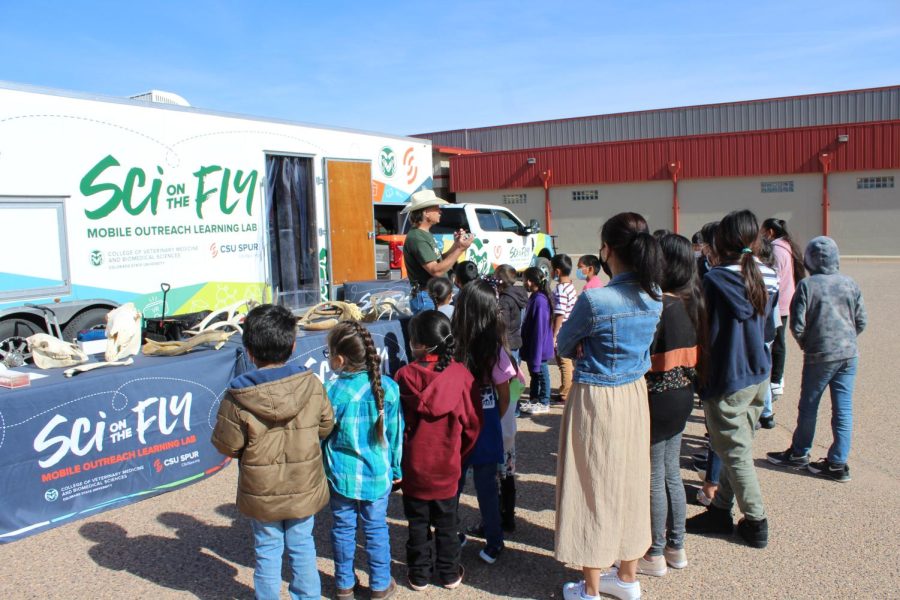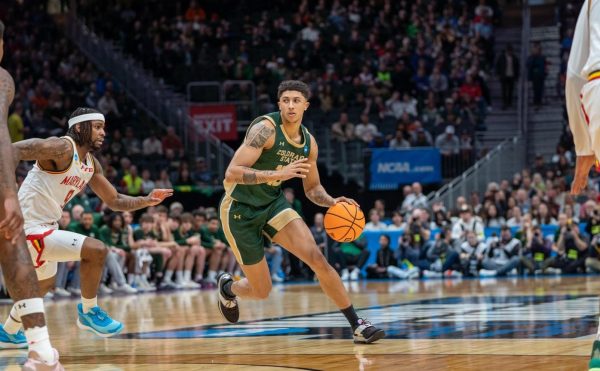CSU mobile science lab conducts research in Navajo Nation
May 31, 2023
Colorado State University employees brought the Sci on the Fly mobile outreach learning lab to Red Mesa, Arizona, to conduct outreach with the Navajo Nation.
CSU employees Wade Ingle, associate director of outreach and engagement for CSU’s College of Veterinary Medicine and Biomedical Sciences; Gilbert John, microbiologist and assistant dean for research at the CVMBS; and Rachael Brard, CVMBS outreach and engagement coordinator in Denver took part in the trip to Red Mesa to conduct outreach and share information from John’s research.
“I think there’s a great opportunity for this outreach effort that we’re making from the college that I think will impact the Navajo Nation and other populations that are underserved” –Gilbert John, assistant dean for research at the College of Veterinary Medicine and Biomedical Sciences
“There are schools on the reservation that were interested in this mobile lab coming to the school, and so we finally were able to work it out,” John said. “We created a theme for this mobile lab to bring examples of science, particularly in areas of the college related to veterinary medicine (and) biomedical sciences, but we also included some of the uranium work that we’ve been doing. And that was an opportunity for the community to see that science is actually happening right in our backyard.”
John is currently doing research on bacteria found in abandoned uranium mining sites near the Four Corners region, including on the reservation in Red Mesa, and the effects it can have on the health of people living nearby.
“We walked (students from Red Mesa) through the mobile outreach lab, so they got to see what a mobile lab looks like,” Brard said. “We had different images of the bacteria … Dr. John had found in that area. … And then they kind of saw the cool stuff, walked through the lab and then at the end, they got to talk to Dr. John, and he had a Geiger counter and other different things with uranium on them.”
John, Brard and Ingle said they want to continue to do outreach like this and hope to return to the reservation annually to travel throughout it with the mobile lab.
“The reservation is fairly rural in terms of the population and also in terms of justice, social and economic status,” John said. “There’s a big range. There’s a small group that are educated and they’re well off, but most of the nation, the people live at the poverty level. Their education is limited, and so they don’t really have a lot of opportunity. … So if you can go to them and utilize the mobile lab like we have and be able to show them some good examples of science and talk a little bit about career opportunities, about education, about how to get there, and then if you have role models, … I think there’s a great opportunity for this outreach effort that we’re making from the college that I think will impact the Navajo Nation and other populations that are underserved.”
Outreach opportunities like this have led Ingle to design and implement the Sci on the Fly mobile labs to deliver programming to students ranging from kindergarten to college. The lab uses unique learning opportunities such as virtual reality, demonstrations, artifact viewing and specimens to educate students and highlight career opportunities in veterinary and biomedical science.
“What’s nice about the mobile labs is that (they) are customized so that we can take technology with us that allows us to deliver programming like virtual reality that otherwise … might not be possible out on the road,” Ingle said.
According to Ingle, the program has been successful, and they plan to continue to engage with populations across Colorado. Brard also hopes to create more programming and further their mentor group and content creation.
“We take mentors who are currently students,” Brard said. “It’s good for when you’re in school, and you just come out on a pretty flexible schedule. Whenever we have an event, we’ll let you know ahead of time, and you can come support for however long or as little as you can. … I definitely want more people to know about that mentor program.”
Brard also noted the need for content in Spanish to be incorporated into the Sci on the Fly programming and hopes to have more bilingual mentors and help creating content in Spanish.
“I have mentors (who) are bilingual, and they’re kind of indispensable because I would love for people to, you know, edit my translations and be present for some of the events that we have, especially upcoming things like fairs,” Brard said.
The labs are often at various fairs and can be requested through this form, and anyone interested in serving as a mentor, creating content and programming or volunteering with the lab can reach out at cvmbs_outreach@colostate.edu.
Reach Jordan Mahaffey at news@collegian.com or on Twitter @_MahaffeyJordan.





